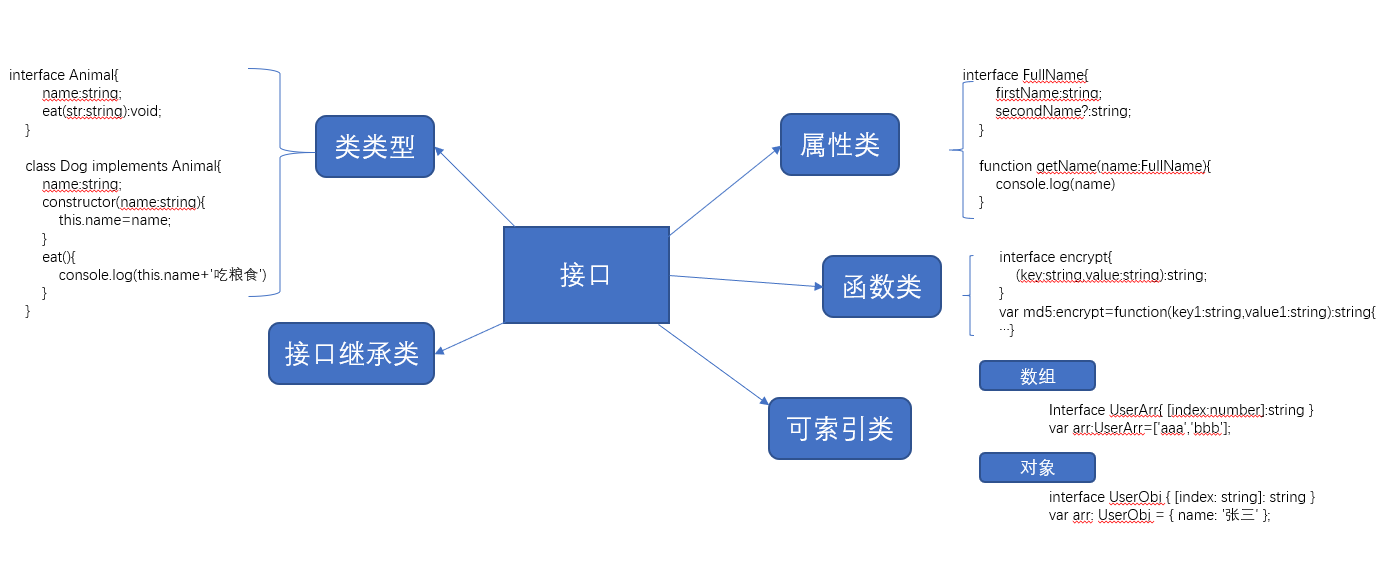
接口的作用:
在面向对象的编程中,接口是一种规范的定义,它定义了行为和动作的规范,在程序设计里面,接口起到一种限制和规范的作用。接口定义了某一批类所需要遵守的规范,接口不关心这些类的内部状态数据,也不关心这些类里方法的实现细节,它只规定这批类里必须提供某些方法,提供这些方法的类就可以满足实际需要。 typescrip中的接口类似于java,同时还增加了更灵活的接口类型,包括属性、函数、可索引和类等。
定义标准。
属性类接口
先来看一个在TS中定义方法
function printLabel():void {
console.log('printLabel');
}
printLabel();
ts中定义方法传入参数
function printLabel(label:string):void {
console.log('printLabel');
}
printLabel('hahah');
ts中自定义方法传入参数,对json进行约束
function printLabel(labelInfo:{label:string}):void {
console.log('printLabel');
}
printLabel('hahah'); //错误写法
printLabel({name:'张三'}); //错误的写法
printLabel({label:'张三'}); //正确的写法
对批量方法传入参数进行约束
接口:行为和动作的规范,对批量方法进行约束
interface FullName {
firstName: string; //注意;结束
secondName: string;
}
function printName(name: FullName) {
// 必须传入对象 firstName secondName
console.log(name.firstName + '--' + name.secondName);
}
function printInfo(info: FullName) {
// 必须传入对象 firstName secondName
console.log(info.firstName + info.secondName);
}
var obj = { /*传入的参数必须包含 firstName secondName*/
age: 20,
firstName: '张',
secondName: '三'
};
printName(obj);
printInfo({
firstName: '李',
secondName: '四'
})
可选属性
interface FullName{
firstName:string;
secondName?:string;
}
function getName(name:FullName){
console.log(name)
}
getName({
firstName:'firstName'
})
函数类型接口
接口能够描述JavaScript中对象拥有的各种各样的外形。 除了描述带有属性的普通对象外,接口也可以描述函数类型。
为了使用接口表示函数类型,我们需要给接口定义一个调用签名。 它就像是一个只有参数列表和返回值类型的函数定义。参数列表里的每个参数都需要名字和类型。
interface encrypt{
(key:string,value:string):string;
}
var md5:encrypt=function(key1:string,value1:string):string{
//模拟操作
return key1+value1;
}
console.log(md5('name','zhangsan'));
函数类型接口:对方法传入的参数 以及返回值进行批量约束。
可索引接口
数组、对象的约束 (不常用)
数组约束
interface UserArr{
[index:number]:string
}
// var arr:UserArr=['aaa','bbb']; //正确
// console.log(arr[0]);
var arr:UserArr=[123,'bbb']; /*错误*/
console.log(arr[0]);
对象约束
interface UserObj {
[index: string]: string
}
var arr: UserObj = { name: '张三' };
类类型接口
对类的约束 和 抽象类抽象有点相似
interface Animal{
name:string;
eat(str:string):void;
}
class Dog implements Animal{
name:string;
constructor(name:string){
this.name=name;
}
eat(){
console.log(this.name+'吃粮食')
}
}
var d=new Dog('小黑');
d.eat();
class Cat implements Animal{
name:string;
constructor(name:string){
this.name=name;
}
eat(food:string){
console.log(this.name+'吃'+food);
}
}
var c=new Cat('小花');
c.eat('老鼠');
接口继承
interface Animal{
eat():void;
}
interface Person extends Animal{
work():void;
}
class Programmer{
public name:string;
constructor(name:string){
this.name=name;
}
coding(code:string){
console.log(this.name+code)
}
}
class Web extends Programmer implements Person{
constructor(name:string){
super(name)
}
eat(){
console.log(this.name+'喜欢吃馒头')
}
work(){
console.log(this.name+'写代码');
}
}
var w=new Web('小李');
// w.eat();
w.coding('写ts代码');